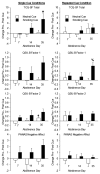Incubation of cue-induced cigarette craving during abstinence in human smokers
- PMID: 20817135
- PMCID: PMC3027849
- DOI: 10.1016/j.biopsych.2010.07.014
Incubation of cue-induced cigarette craving during abstinence in human smokers
Abstract
Background: Abstinent drug users remain at risk for relapse long after withdrawal subsides. Animal studies indicate that responses to drug-related cues not only persist but increase with abstinence, a phenomenon termed "incubation of drug craving." It is unknown whether cue-induced craving increases, decreases, or remains constant with abstinence in humans. We investigated effects of abstinence on cue-induced craving in cigarette smokers.
Methods: Eighty-six non-treatment-seeking, adult smokers (≥10 cigarettes daily) were paid to abstain for 7 (Group 1), 14 (Group 2), or 35 (Groups 3 and 4) days. Abstinence was verified daily. Groups 1, 2, and 3 underwent a single cue session on the final abstinence day (7, 14, or 35). Group 4 viewed cues on Days 7, 14, and 35.
Results: Between and within groups, smoking-cue-induced craving increased with abstinence on some measures. Cue-induced craving was greater in Group 3 (35-day) compared with Group 1 (7-day). Within Group 4, cue-induced craving was greater at 35 than 14 days. Cue-induced craving did not decrease with abstinence on any measure.
Conclusions: We present initial evidence of incubation of cue-induced craving in humans. The observation that cue-induced craving increases with abstinence, even as "background" craving and withdrawal symptoms subside, might have treatment implications.
Copyright © 2011 Society of Biological Psychiatry. All rights reserved.
Figures


References
-
- Hunt WA, Barnett LW, Branch LG. Relapse rates in addiction programs. J Clin Psychol. 1971;27:455–456. - PubMed
-
- Shi J, Jun W, Zhao LY, Xue YX, Zhang XY, Kosten TR, Lu L. Effect of rapamycin on cue-induced drug craving in abstinent heroin addicts. Eur J Pharmacol. 2009;615:108–112. - PubMed
-
- Carter BL, Tiffany ST. Meta-analysis of cue-reactivity in addiction research. Addiction. 1999;94:327–340. - PubMed
Publication types
MeSH terms
Grants and funding
LinkOut - more resources
Full Text Sources

